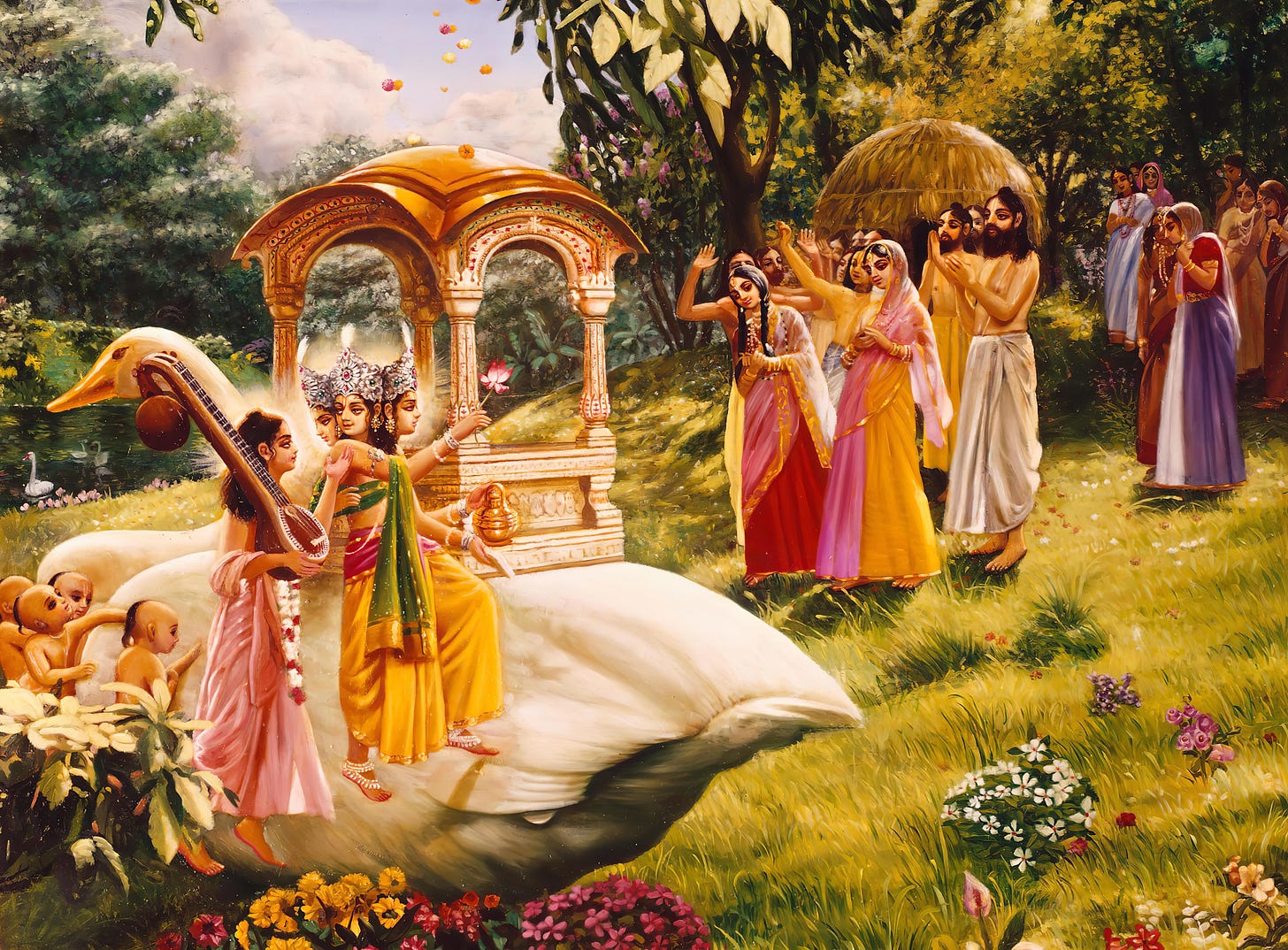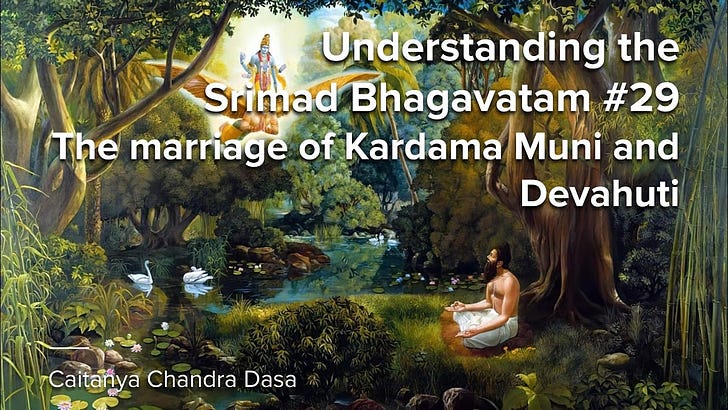The descendants of Kardama Muni and Devahūti
Much is spoken about the glorious marriage of Kardama Muni and Devahūti and the lessons we can learn from their family life, but it is not very common to hear about their descendants.
Much is spoken about the glorious marriage of Kardama Muni and Devahūti and the lessons we can learn from their family life, but it is not very common to hear about their descendants and their contribution to the development of our universe.
As mentioned in the 3rd canto, apart from Lord Kapila, Kardama Muni and Devahūti had nine daughters, who were married to great sages. In his purport to SB 3.24.15, Prabhupada mentions: “The nine principal ṛṣis, or sages, are Marīci, Atri, Aṅgirā, Pulastya, Pulaha, Kratu, Bhṛgu, Vasiṣṭha, and Atharvā. All these ṛṣis are most important, and Brahmā desired that the nine daughters already born of Kardama Muni be handed over to them.”
Therefore, all these daughters married great sages, who were direct sons of Brahma. Their descendants are:
1) Kalā married Marīci and gave birth to two children, whose names were Kaśyapa and Pūrṇimā. This Kaśyapa is different from the Kaśyapa described in the third canto, who married Diti and Aditi. The other Kaśyapa is the son of Marīci, and his story happens much later, in the 6th Manvantara. The Kaśyapa mentioned here was a sage who didn’t leave descendants. His brother Pūrṇimā, on the other hand, begot three children (Viraja, Viśvaga, and Devakulyā). Their descendants “are spread all over the world”, indicating that their family expanded into many branches and sub-branches that are still current, even after billions of years.
2) Anasūyā married Atri Muni. They gave birth to three very famous sons – Soma, Dattātreya, and Durvāsā, who were partial representations of Lord Viṣṇu, Lord Śiva, and Lord Brahmā. Soma was a partial representation of Lord Brahmā, Dattātreya was a partial representation of Lord Viṣṇu, and Durvāsā was a partial representation of Lord Śiva.
In the Srimad Bhagavatam, Vidura inquires about this curious pastime, and Maitreya describes the details in verses 17 to 33.
After their marriage, Atri and Anasūyā went on to perform austerities for 100 years. Despite his devotional attitude, Atri had no clear concept of the personality of Godhead. He didn’t know His name, and apparently didn’t understand the concept of God being Supreme, without an equal, since the purpose of his austerities was to obtain a son on the same level as Him. Prabhupada explains that he approached the Lord just like the four classes of pious persons described in the Bhagavad-Gita (the distressed, the one desiring wealth, etc). Prabhupada concludes that Atri was not a pure devotee and his desire to beget a son like the Lord was material. He didn’t want the Lord as his son, but someone like Him.
Still, because of his meditation on the Supersoul and his austerities, Lord Brahma and Shiva appeared with Lord Viṣnu to see him. Because Atri Muni was confused about who was the Supreme Personality of Godhead, all three of them appeared to him and agreed to become his sons.
In his purport to 4.1.30, Srila Prabhupada explains:
“Atri Muni unspecifically thought of the Personality of Godhead, the Lord of the universe, although he had no clear idea of the Lord of the universe nor of His specific form. Mahā-Viṣṇu, from whose breathing millions of universes emanate and into whom they are again withdrawn, may be accepted as the Lord of the universe. Garbhodakaśāyī Viṣṇu, from whose abdomen sprouted the lotus flower, which is the birthplace of Brahmā, may also be considered the Lord of the universe. Similarly, Kṣīrodakaśāyī Viṣṇu, who is the Supersoul of all living entities, may also be considered the Lord of the universe. Then, under the order of Kṣīrodakaśāyī Viṣṇu, the Viṣṇu form within this universe, Lord Brahmā and Lord Śiva may also be accepted as the Lords of the universe.”
“Atri Muni had no clear conception of the Lord of the universe; therefore, the three presiding deities who are actually the lords of the universe in the three departments of the modes of nature all came before him. Now, according to the strength of his determination for a son, his desire would be fulfilled by the grace of the Lord.”
Prabhupada gives another account of this story in his purport to SB 1.3.11: “The Lord incarnated Himself as Dattātreya, the son of Ṛṣi Atri and Anasūyā. The history of the birth of Dattātreya as an incarnation of the Lord is mentioned in the Brahmāṇḍa Purāṇa in connection with the story of the devoted wife. It is said there that Anasūyā, the wife of Ṛṣi Atri, prayed before the Lords Brahmā, Viṣṇu and Śiva as follows: “My lords, if you are pleased with me, and if you desire me to ask from you some sort of blessings, then I pray that you combine together to become my son.” This was accepted by the lords, and as Dattātreya the Lord expounded the philosophy of the spirit soul and especially instructed Alarka, Prahlāda, Yadu, Haihaya, etc.”
From this description, it appears that not only Atri prayed, but also Anasūyā. She asked for a son who would be a combination of the three Lords. Since Lord Viṣnu is the source of both Brahma and Shiva, Dattātreya, who is His incarnation, can be considered the combination of the three deities. Together with Him came also Soma (the moon-god) and Durvāsā, who were partial incarnations of Brahma and Shiva.
3) Śraddhā married Aṅgirā. They gave birth to four daughters, named Sinīvālī, Kuhū, Rākā and Anumati. They had also two sons: Utathya and Bṛhaspati (who became the guru of the demigods). From this description, it appears that Bṛhaspati lives for the entire day of Brahma, serving as guru for different generations of demigods in different Manvantaras.
4) Havirbhū married Pulastya. They had two sons: Agastya and Viśravā. The second son, Viśravā had two wives. From the first. Iḍaviḍā was born Kuvera, the treasurer of the demigods and master of the Yakṣas who live in the planetary system of Bhuvarloka (the planetary system immediately above ours). Bhuvarloka starts in the upper atmosphere and extends all the deep space, where Svargaloka starts and can be accessed from our plane by qualified people through subtle passages in the Himalayas, just like the Pandavas did. The second wife of Viśravā was Keśinī, from whom Rāvaṇa, Kumbhakarṇa, and Vibhīṣaṇa were born.
Viśravā is described as being a saintly person, and Vibhīṣaṇa shared these saintly qualities. Rāvaṇa and Kumbhakarṇa were two great demons, but in reality, they were Jaya and Vijaya, playing their pastimes as demons. This explains how they could take birth from such an exalted father.
5) Gati married Pulaha and gave birth to three very good sons who became great sages: Karmaśreṣṭha, Varīyān, and Sahiṣṇu.
6) Kriyā married Kratu and gave birth to sixty thousand great sages, named the Vālakhilyas, who were very exalted in spiritual knowledge.
7) Ūrjā (Arundhatī) married Vasiṣṭha and bore seven spotlessly great sages: Citraketu, Suroci, Virajā, Mitra, Ulbaṇa, Vasubhṛdyāna, and Dyumān. The Citraketu described here is not the same Citraketu who is described in the 6th canto of Srimad Bhagavatam as being cursed by Lord Shiva and taking his next birth as Vṛtrāsura. The son of Ūrjā was a great sage, while the Citraketu described in the 6th canto was a Ksatriya, born much later.
8) Citti (Śānti) married Atharvā and gave birth to a son named Aśvaśirā by accepting a great vow called Dadhyañca. There are no particular pastimes connected with Aśvaśirā; he is just described as a great sage who had deep spiritual wisdom.
9) Khyāti married Bhṛgu and gave birth to two sons, named Dhātā and Vidhātā, and one daughter, named Śrī, who was a great Vaiṣnavi. The two sons married the daughters of the sage Meru. Amongst their descendants are Mārkaṇḍeya Muni (who survived the devastation of the universe, as described in the 12th canto) and Śukrācārya, the great Brāhmana who acts as the priest of the demons.
Read also:



